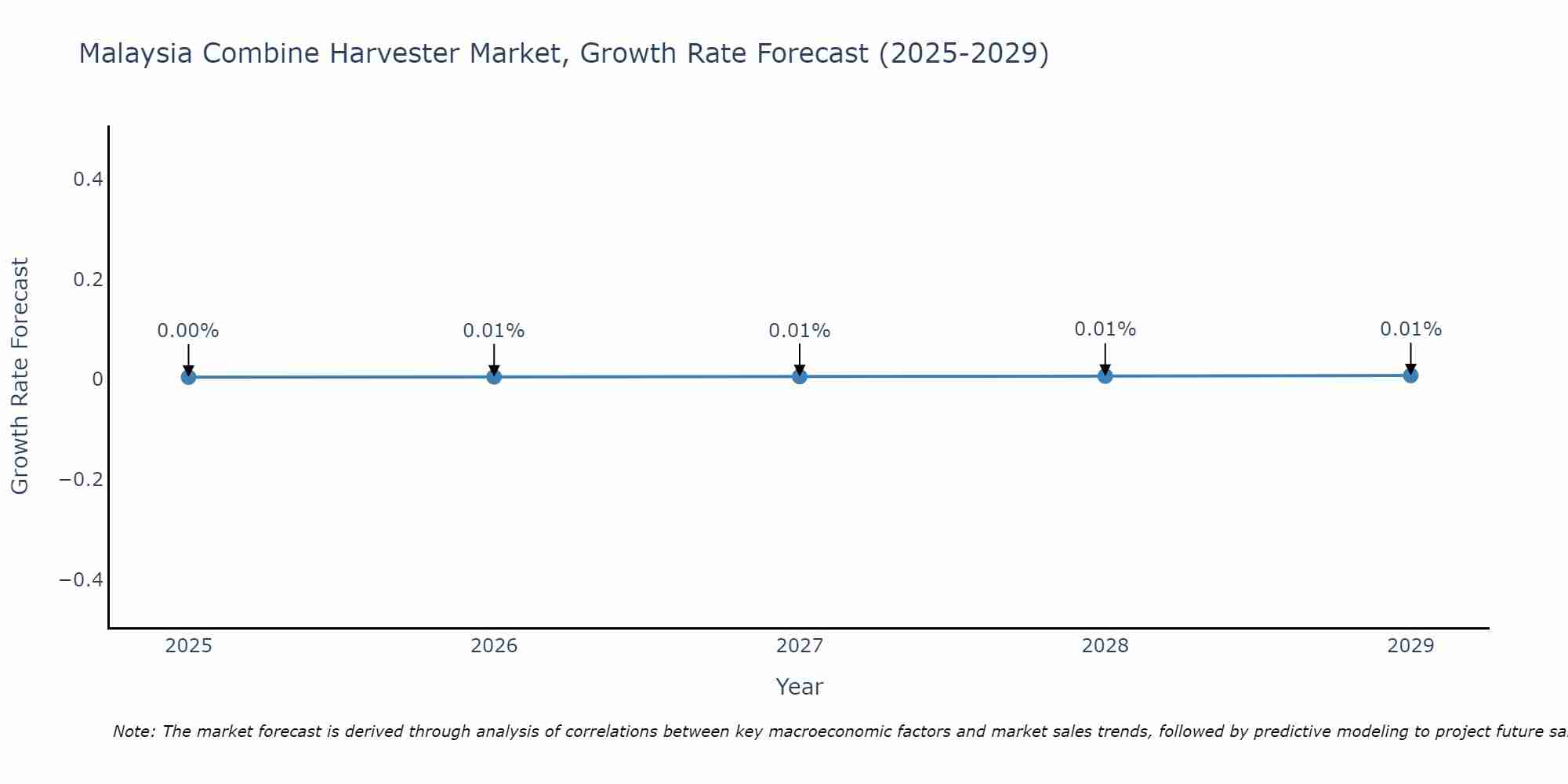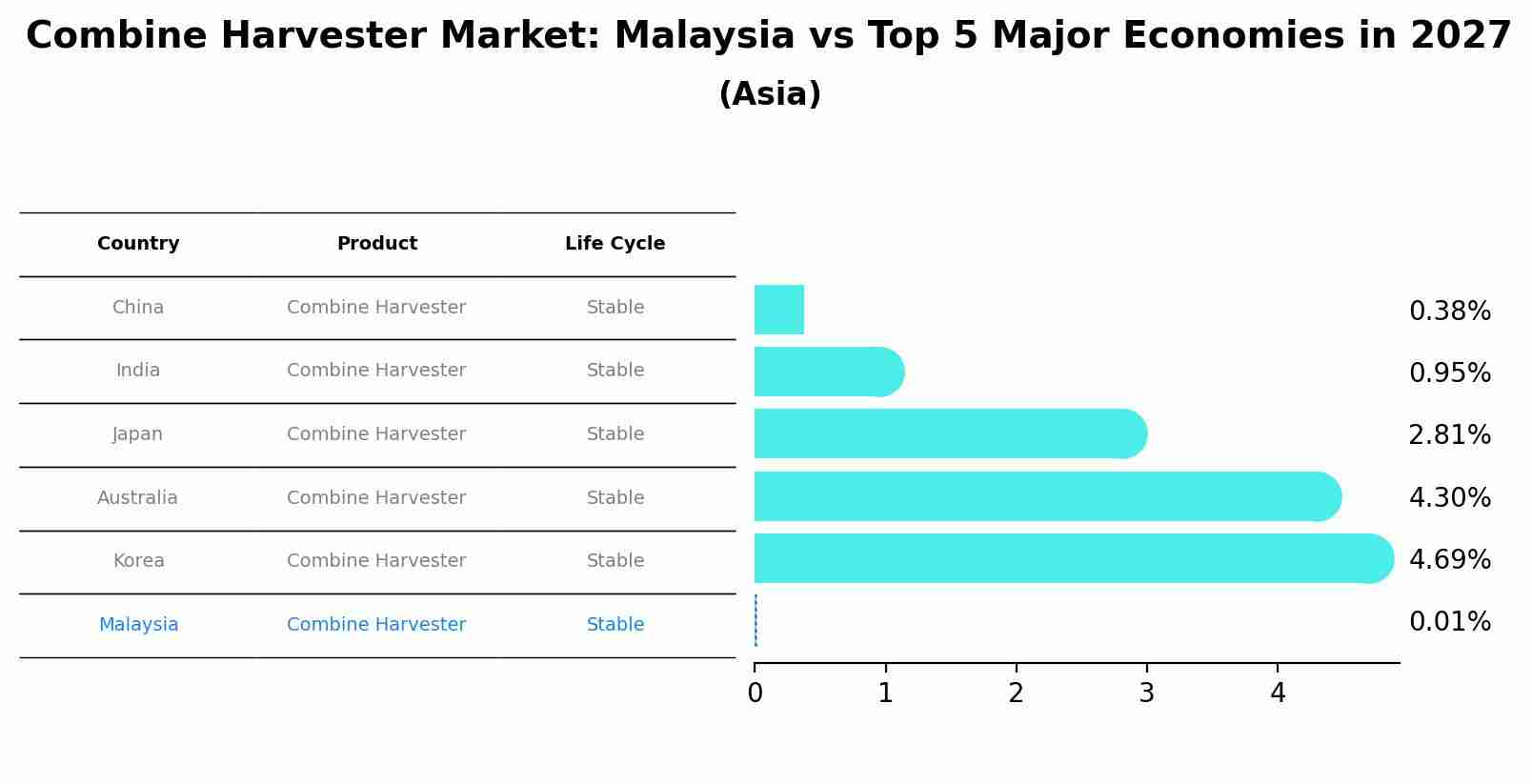Malaysia Combine Harvester Market (2025-2031) Outlook | Analysis, Share, Forecast, Companies, Industry, Revenue, Value, Growth, Size & Trends
| Product Code: ETC428722 | Publication Date: Oct 2022 | Updated Date: Aug 2025 | Product Type: Market Research Report | |
| Publisher: 6Wresearch | Author: Ravi Bhandari | No. of Pages: 75 | No. of Figures: 35 | No. of Tables: 20 |
Malaysia Combine Harvester Market Size Growth Rate
The Malaysia Combine Harvester Market is poised for steady growth rate improvements from 2025 to 2029. Commencing at 0.00% in 2025, growth builds up to 0.01% by 2029.

Combine Harvester Market: Malaysia vs Top 5 Major Economies in 2027 (Asia)
By 2027, Malaysia's Combine Harvester market is forecasted to achieve a stable growth rate of 0.01%, with China leading the Asia region, followed by India, Japan, Australia and South Korea.

Malaysia Combine Harvester Market Synopsis
The combine harvester market is closely linked to the agriculture sector in Malaysia. With a focus on modernizing agricultural practices and improving productivity, the demand for combine harvesters is likely to increase. Government initiatives and support for agricultural mechanization will play a significant role in shaping the market`s future.
Drivers of the Market
The combine harvester market in Malaysia is expected to experience growth in the coming years, driven by several key factors. Firstly, the agriculture sector in Malaysia is modernizing and adopting mechanized farming practices to increase efficiency and productivity. Combine harvesters are essential machines for harvesting crops such as rice and wheat, and their demand is directly linked to the expansion of mechanized farming. Secondly, government support and incentives for the adoption of advanced agricultural machinery are encouraging farmers to invest in combine harvesters. Additionally, the need to reduce labor costs and improve harvesting speed and accuracy is driving the adoption of combine harvesters in Malaysia agriculture sector. As a result, the market for combine harvesters is likely to witness positive growth in the country.
Challenges of the Market
The combine harvester market in Malaysia is linked to the agriculture sector. Market growth depends on factors such as government policies, weather conditions, and farmers` investment capacity. Challenges include the high cost of modern combine harvesters, maintenance requirements, and competition from traditional farming methods.
COVID-19 Impact on the Market
The combine harvester market in Malaysia experienced challenges during the COVID-19 pandemic as agriculture was affected by supply chain disruptions and labor shortages. However, agriculture remains a crucial sector for food production and the economy. As the government supports the modernization of agriculture and farmers seek efficient harvesting solutions, the demand for combine harvesters is expected to recover. Innovations in combine harvester technology, such as improved harvesting efficiency and reduced environmental impact, may further drive market growth.
Key Players in the Market
The combine harvester market in Malaysia is led by major players including HarvesterTech Solutions, AgriCombine Machinery, and HarvestMaster Equipment. These companies provide a range of combine harvester models designed for efficient crop harvesting in the agriculture sector. HarvesterTech Solutions, known for its advanced technology and after-sales support, has a strong presence in the market. With the agriculture industry`s ongoing modernization and the need for increased productivity, the demand for combine harvesters is expected to rise. These key players are well-positioned to capitalize on this growth and maintain their market dominance.
Key Highlights of the Report:
- Malaysia Combine Harvester Market Outlook
- Market Size of Malaysia Combine Harvester Market, 2024
- Forecast of Malaysia Combine Harvester Market, 2031
- Historical Data and Forecast of Malaysia Combine Harvester Revenues & Volume for the Period 2021-2031
- Malaysia Combine Harvester Market Trend Evolution
- Malaysia Combine Harvester Market Drivers and Challenges
- Malaysia Combine Harvester Price Trends
- Malaysia Combine Harvester Porter's Five Forces
- Malaysia Combine Harvester Industry Life Cycle
- Historical Data and Forecast of Malaysia Combine Harvester Market Revenues & Volume By Cutting Width for the Period 2021-2031
- Historical Data and Forecast of Malaysia Combine Harvester Market Revenues & Volume By Small Size Combine Harvester for the Period 2021-2031
- Historical Data and Forecast of Malaysia Combine Harvester Market Revenues & Volume By Large Size Combine Harvester for the Period 2021-2031
- Historical Data and Forecast of Malaysia Combine Harvester Market Revenues & Volume By Type for the Period 2021-2031
- Historical Data and Forecast of Malaysia Combine Harvester Market Revenues & Volume By Wheel Type Combine Harvester for the Period 2021-2031
- Historical Data and Forecast of Malaysia Combine Harvester Market Revenues & Volume By Crawler Type Combine Harvester for the Period 2021-2031
- Historical Data and Forecast of Malaysia Combine Harvester Market Revenues & Volume By Power Source for the Period 2021-2031
- Historical Data and Forecast of Malaysia Combine Harvester Market Revenues & Volume By Tractor Pulled/PTO Powered Combine Harvester for the Period 2021-2031
- Historical Data and Forecast of Malaysia Combine Harvester Market Revenues & Volume By Self-Propelled Combine Harvester for the Period 2021-2031
- Malaysia Combine Harvester Import Export Trade Statistics
- Market Opportunity Assessment By Cutting Width
- Market Opportunity Assessment By Type
- Market Opportunity Assessment By Power Source
- Malaysia Combine Harvester Top Companies Market Share
- Malaysia Combine Harvester Competitive Benchmarking By Technical and Operational Parameters
- Malaysia Combine Harvester Company Profiles
- Malaysia Combine Harvester Key Strategic Recommendations
Frequently Asked Questions About the Market Study (FAQs):
1 Executive Summary |
2 Introduction |
2.1 Key Highlights of the Report |
2.2 Report Description |
2.3 Market Scope & Segmentation |
2.4 Research Methodology |
2.5 Assumptions |
3 Malaysia Combine Harvester Market Overview |
3.1 Malaysia Country Macro Economic Indicators |
3.2 Malaysia Combine Harvester Market Revenues & Volume, 2021 & 2031F |
3.3 Malaysia Combine Harvester Market - Industry Life Cycle |
3.4 Malaysia Combine Harvester Market - Porter's Five Forces |
3.5 Malaysia Combine Harvester Market Revenues & Volume Share, By Cutting Width, 2021 & 2031F |
3.6 Malaysia Combine Harvester Market Revenues & Volume Share, By Type, 2021 & 2031F |
3.7 Malaysia Combine Harvester Market Revenues & Volume Share, By Power Source, 2021 & 2031F |
4 Malaysia Combine Harvester Market Dynamics |
4.1 Impact Analysis |
4.2 Market Drivers |
4.2.1 Increasing demand for mechanization in agriculture sector |
4.2.2 Government support and subsidies for modern farming equipment |
4.2.3 Growing adoption of precision farming techniques |
4.2.4 Expansion of commercial farming operations |
4.2.5 Technological advancements in combine harvester machinery |
4.3 Market Restraints |
4.3.1 High initial investment cost of combine harvesters |
4.3.2 Limited awareness and education among farmers about benefits of mechanization |
4.3.3 Fragmented land ownership and small-scale farming practices |
4.3.4 Dependence on seasonal factors affecting agriculture |
4.3.5 Lack of infrastructure and access to financing for farmers |
5 Malaysia Combine Harvester Market Trends |
6 Malaysia Combine Harvester Market, By Types |
6.1 Malaysia Combine Harvester Market, By Cutting Width |
6.1.1 Overview and Analysis |
6.1.2 Malaysia Combine Harvester Market Revenues & Volume, By Cutting Width, 2021-2031F |
6.1.3 Malaysia Combine Harvester Market Revenues & Volume, By Small Size Combine Harvester, 2021-2031F |
6.1.4 Malaysia Combine Harvester Market Revenues & Volume, By Large Size Combine Harvester, 2021-2031F |
6.2 Malaysia Combine Harvester Market, By Type |
6.2.1 Overview and Analysis |
6.2.2 Malaysia Combine Harvester Market Revenues & Volume, By Wheel Type Combine Harvester, 2021-2031F |
6.2.3 Malaysia Combine Harvester Market Revenues & Volume, By Crawler Type Combine Harvester, 2021-2031F |
6.3 Malaysia Combine Harvester Market, By Power Source |
6.3.1 Overview and Analysis |
6.3.2 Malaysia Combine Harvester Market Revenues & Volume, By Tractor Pulled/PTO Powered Combine Harvester, 2021-2031F |
6.3.3 Malaysia Combine Harvester Market Revenues & Volume, By Self-Propelled Combine Harvester, 2021-2031F |
7 Malaysia Combine Harvester Market Import-Export Trade Statistics |
7.1 Malaysia Combine Harvester Market Export to Major Countries |
7.2 Malaysia Combine Harvester Market Imports from Major Countries |
8 Malaysia Combine Harvester Market Key Performance Indicators |
8.1 Average age of combine harvester fleet in Malaysia |
8.2 Adoption rate of precision farming technologies in the country |
8.3 Utilization rate of combine harvesters during peak harvesting seasons |
8.4 Percentage of farmers receiving government subsidies for agricultural machinery |
8.5 Efficiency improvement in crop yield per unit area harvested |
9 Malaysia Combine Harvester Market - Opportunity Assessment |
9.1 Malaysia Combine Harvester Market Opportunity Assessment, By Cutting Width, 2021 & 2031F |
9.2 Malaysia Combine Harvester Market Opportunity Assessment, By Type, 2021 & 2031F |
9.3 Malaysia Combine Harvester Market Opportunity Assessment, By Power Source, 2021 & 2031F |
10 Malaysia Combine Harvester Market - Competitive Landscape |
10.1 Malaysia Combine Harvester Market Revenue Share, By Companies, 2024 |
10.2 Malaysia Combine Harvester Market Competitive Benchmarking, By Operating and Technical Parameters |
11 Company Profiles |
12 Recommendations |
13 Disclaimer |
- Single User License$ 1,995
- Department License$ 2,400
- Site License$ 3,120
- Global License$ 3,795
Search
Thought Leadership and Analyst Meet
Our Clients
Related Reports
- Germany Breakfast Food Market (2026-2032) | Industry, Share, Growth, Size, Companies, Value, Analysis, Revenue, Trends, Forecast & Outlook
- Australia Briquette Market (2025-2031) | Growth, Size, Revenue, Forecast, Analysis, Trends, Value, Share, Industry & Companies
- Vietnam System Integrator Market (2025-2031) | Size, Companies, Analysis, Industry, Value, Forecast, Growth, Trends, Revenue & Share
- ASEAN and Thailand Brain Health Supplements Market (2025-2031) | Strategy, Consumer Insights, Analysis, Investment Trends, Opportunities, Growth, Size, Share, Industry, Revenue, Segments, Value, Segmentation, Supply, Forecast, Restraints, Outlook, Competition, Drivers, Trends, Demand, Pricing Analysis, Competitive, Strategic Insights, Companies, Challenges
- ASEAN Bearings Market (2025-2031) | Strategy, Consumer Insights, Analysis, Investment Trends, Opportunities, Growth, Size, Share, Industry, Revenue, Segments, Value, Segmentation, Supply, Forecast, Restraints, Outlook, Competition, Drivers, Trends, Demand, Pricing Analysis, Competitive, Strategic Insights, Companies, Challenges
- Europe Flooring Market (2025-2031) | Outlook, Share, Industry, Trends, Forecast, Companies, Revenue, Size, Analysis, Growth & Value
- Saudi Arabia Manlift Market (2025-2031) | Outlook, Size, Growth, Trends, Companies, Industry, Revenue, Value, Share, Forecast & Analysis
- Uganda Excavator, Crane, and Wheel Loaders Market (2025-2031) | Strategy, Consumer Insights, Analysis, Investment Trends, Opportunities, Growth, Size, Share, Industry, Revenue, Segments, Value, Segmentation, Supply, Forecast, Restraints, Outlook, Competition, Drivers, Trends, Demand, Pricing Analysis, Competitive, Strategic Insights, Companies, Challenges
- Rwanda Excavator, Crane, and Wheel Loaders Market (2025-2031) | Strategy, Consumer Insights, Analysis, Investment Trends, Opportunities, Growth, Size, Share, Industry, Revenue, Segments, Value, Segmentation, Supply, Forecast, Restraints, Outlook, Competition, Drivers, Trends, Demand, Pricing Analysis, Competitive, Strategic Insights, Companies, Challenges
- Kenya Excavator, Crane, and Wheel Loaders Market (2025-2031) | Strategy, Consumer Insights, Analysis, Investment Trends, Opportunities, Growth, Size, Share, Industry, Revenue, Segments, Value, Segmentation, Supply, Forecast, Restraints, Outlook, Competition, Drivers, Trends, Demand, Pricing Analysis, Competitive, Strategic Insights, Companies, Challenges
Industry Events and Analyst Meet
Whitepaper
- Middle East & Africa Commercial Security Market Click here to view more.
- Middle East & Africa Fire Safety Systems & Equipment Market Click here to view more.
- GCC Drone Market Click here to view more.
- Middle East Lighting Fixture Market Click here to view more.
- GCC Physical & Perimeter Security Market Click here to view more.
6WResearch In News
- Doha a strategic location for EV manufacturing hub: IPA Qatar
- Demand for luxury TVs surging in the GCC, says Samsung
- Empowering Growth: The Thriving Journey of Bangladesh’s Cable Industry
- Demand for luxury TVs surging in the GCC, says Samsung
- Video call with a traditional healer? Once unthinkable, it’s now common in South Africa
- Intelligent Buildings To Smooth GCC’s Path To Net Zero


















